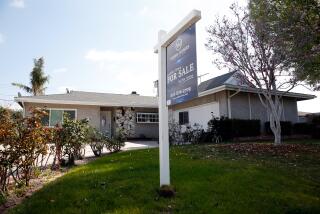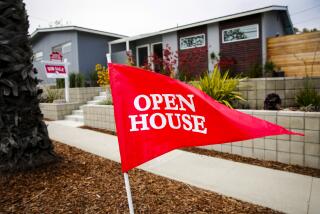Unsold New Homes Hit Record as Sales Slip 5%
- Share via
WASHINGTON — The nationwide backlog of unsold new homes reached a record level last month as sales slipped despite the warmest January in more than 100 years. However, new-home sales rose in the West, which includes California.
The Commerce Department reported Monday that sales of new single-family homes dropped 5% to a seasonally adjusted annual rate of 1.23 million units last month.
That was the slowest pace since January 2005 and left the number of unsold homes at a record high of 528,000.
Analysts viewed the new data as further evidence that the U.S. housing market, which hit record sales levels for five straight years, is cooling.
“The decline in new-home sales in January makes it clear that there is some real softening in the housing market,” said Joel Naroff, chief economist at Naroff Economic Advisors.
The surprise 5% decline dashed hopes that the milder-than-normal January would bolster demand. The warm weather had pushed up construction starts last month by 14.5%, the fastest rate in three decades.
Even with the softening in sales, prices rose in January, with the median climbing to $238,100, up 4% from December but below the all-time high of $243,900 set in October.
For the last few years, home prices have surged at double-digit rates. Analysts say such gains are likely to slow now that sales are easing and inventories of unsold homes are rising.
Ian Shepherdson, chief U.S. economist at High Frequency Economics, predicted “real downward pressure on prices over the next few months.”
David Seiders, chief economist for the National Assn. of Home Builders, said surveys showed that the number of builders who were throwing in amenities for free to move homes had risen to 41%.
Seiders predicted that price gains, which amounted to about 12% last year, would slow to 6% this year.
He said a lot of the change in 2006 would reflect less speculative investing and more sales to prospective residents. “Hopefully, that is all that is developing here,” Seiders said.
Some economists worry that significant price pressure may accompany the rising inventory of unsold homes, triggering a chain reaction similar to the bursting of the stock market bubble in 2000, which contributed to the 2001 recession.
But new Federal Reserve Chairman Ben S. Bernanke told Congress this month that for now he was expecting a moderate slowdown in the housing industry, not a crash.
January’s 5% sales slide followed a revised 3.8% increase in December but was smaller than November’s 7% drop.
Bucking the national trend, sales in the West posted an 11.3% increase in January after a 6.3% gain in December.
The Northeast saw the biggest decline in sales at 14.9%, which followed an even bigger 23% plunge in December. Sales in the Midwest were down 10.8% after they jumped 21.2% in December.
In the South, sales fell 10.3% in January in the wake of December’s 1.2% gain.
More to Read
Inside the business of entertainment
The Wide Shot brings you news, analysis and insights on everything from streaming wars to production — and what it all means for the future.
You may occasionally receive promotional content from the Los Angeles Times.










